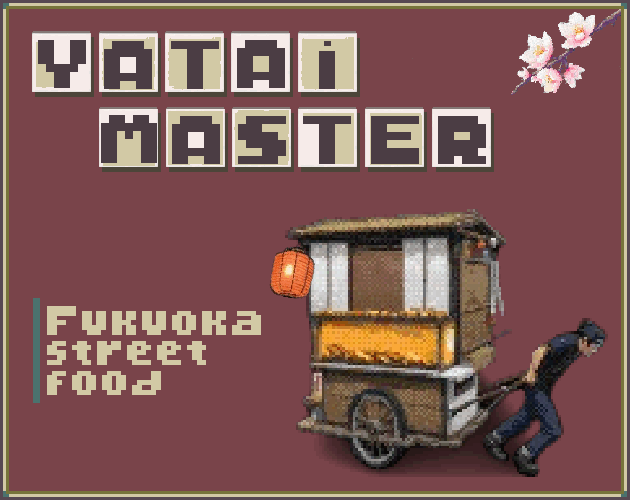Yatai as story hubs. Developing tales around japanese street stalls
Originally published on: Developing tales around japanese street stalls.
Despite the 18,000 kilometers separating me from Japan and the fact that I've never set foot in the “Land of the Rising Sun”, I'm a big fan of yatai.
This puzzling enthusiasm for Japanese food stalls (I’m not a big fan of cooking in general) is what led me to consider the idea of creating a game around this theme when it came up in a brainstorming session.
However, it wasn't until I learned about the story of Takahashi and his ramen stall, “Koeiken”, that I became fully committed to tackling the project with more determination.
"I'll make ramen until my soul burns out" — Takahashi.

The references
While researching the “state of the art” of yatai-related video games, I came across two games (developed for PlayStation 1) that seem to be little known in the West and whose existence I had been completely unaware of. These games are: Charumera and Ramenbashi.

Both games turned out to be enlightening, and they now serve as a guide for developing the main concepts of my game. (I’ll talk more about them in future posts.)
But let’s start with the basics…
What is a yatai?
Yatai are street food stalls. One of the unique aspects of these establishments is their mobility. Although they usually occupy the same spot almost every night, these stalls are removed at the end of the workday.
Initially, yatai were small, two-wheeled wooden carts equipped with cooking utensils and a rustic bar for serving customers.
Today, yatai retain their mobile heritage, but are generally larger. Some can host over 10 diners around the counter, depending on the yatai's setup and the time of year (in winter, surrounding areas are usually not used for additional tables).
The food
At yatai, you can enjoy a wide variety of traditional street food dishes, ranging from ramen and yakitori (grilled chicken skewers) to oden (a stew of fish, eggs, and vegetables).

Other classics include gyoza (dumplings filled with meat and vegetables), okonomiyaki (a type of savory pancake with various ingredients), and tempura with vegetables and seafood.

Fukuoka
Fukuoka, located on the island of Kyushu, is one of the few prefectures in Japan that still preserves a significant number of yatai, 103 to be exact, according to information provided by Fukuoka’s government website, updated as of January 2024.
The city is well-known for its Hakata ramen, a rich pork broth that has become a local icon, and many yatai offer it as a main dish.
Beyond being a tradition, yatai in Fukuoka are a cultural and tourist attraction. So much so that there are various initiatives aimed at showcasing this unique culinary experience.
These include specialized information centers that provide guidance to tourists about yatai:

A map showing the distribution of the food stalls:
And even a search engine that allows users to find yatai according to different criteria:
For these reasons, I decided to name the game after Fukuoka, although I’m still uncertain if this will ultimately be relevant.
Yatai as a “third place”
These food carts not only offer an accessible dish but have also become gathering spaces for certain sectors of society, consolidating yatai as social meeting points.
I found quite a few references highlighting this social component of yatai:
“Don't be shy! Yatai is a friendly, open environment, so don’t be surprised if your neighbor strikes up a conversation with you.” — fukuokaeats.com
“Normally, I don’t like crowded places, but it was fun to be squeezed into a small space like that over beers and skewers of yakitori.” — JB and Renée
It’s this aspect of a “third place”, rather than the food preparation itself, that I find interesting to capture in the game.
Developing different stories around the yatai bar represents a narrative challenge, as it seeks, to some extent, to simulate the connection between people that helps build community in an environment that appears relaxed and non-hierarchical.
P.S.: If the English in this article seems a bit odd to you, let me tell you, you're not mistaken. It was translated from Spanish to English by ChatGPT.
Yatai Master
Navigate the challenges of operating a yatai, balancing limited supplies and hungry customers in a cozy mobile kitchen.
| Status | In development |
| Author | oh! |
| Genre | Simulation |
| Tags | 2D, Cooking, japan, Pixel Art, yatai |
| Languages | English |
More posts
- Redesigning Yatai Master’s aesthetic and quality system44 days ago
- The Road to Beta.78 days ago
- Progress in dialogue writingJan 31, 2025
- The quest for better ingredientsJan 28, 2025
- Splash screenJan 09, 2025
- Bringing Yatai to life with mediaJan 02, 2025
- Building relationships: The social componentOct 23, 2024
- Behind Yatai Master’s InterfaceOct 17, 2024






Leave a comment
Log in with itch.io to leave a comment.